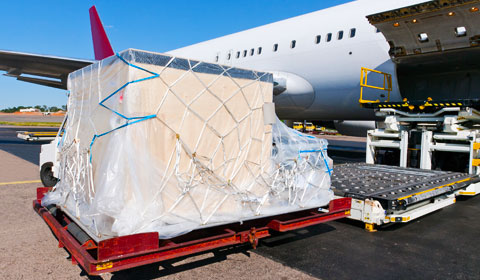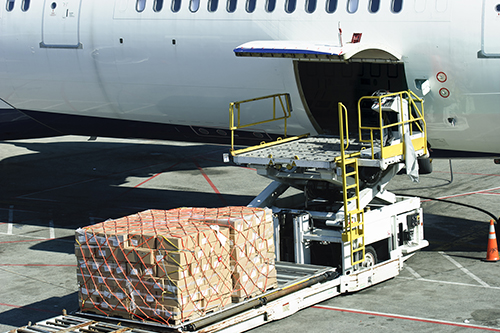Free Airline Cargo Assistant course (6months)
Airline Cargo Assistant:
Brief Job Description of Airline Cargo Assistant: Ensures smooth handling of cargo throughout Cargo / Ramp Operations by performing multi-skilled role while utilising the resources provided effectively. Tasks required to perform Air cargo handling include, but are not limited to, documentation, customer service, acceptance, delivery, breakdown, build up, equipment operation and transport.
Personal Attributes: The individual should have basic communication skills and good inter-personal skills. Ability to stand and walk for long periods of time with consistent kneeling, squatting and reaching above the head.


Safety and security procedures:-
Comprehending the safety and security procedures
PC1. comply with the organisation’s safety and security policies and procedures
PC2. comply with the regulatory guidelines on safe conduct of operations and maintenance of conditions to thwart any acts of unlawful interference
PC3. report any identified breaches of safety, and security policies and procedures to the designated person
PC4. coordinate with other resources at the workplace (within and outside the organisation) to achieve safe and secure environment
PC5. identify and mitigate any safety and security hazards like illness, accidents, fires or acts of unlawful interference if it falls within the limits of individual’s authority
PC6. report any hazards outside the individual’s authority to the relevant person in line with organisational procedures and regulatory guidelines
PC7. follow organisation’s emergency procedures for accidents, fires or acts of unlawful interference
PC8. identify and recommend opportunities for improving health, safety, and security to the designated person
PC9. complete all health and safety records are updates and procedures well defined
Knowledge and Understanding

Organisational Context
KA1. hazard identification and risk management as defined within the organisational policy and procedures
KA2. regulatory requirements and organisation’s procedures for maintenance of safety and security standards and individual’s role and responsibilities in relation to this
KA3. how and when to report hazards
KA4. the limits of responsibility for dealing with hazards KA5. the organisation’s emergency procedures for different emergency situations and the importance of following these
KA6. importance of maintaining high standards of safety and security KA7. implications that any non-compliance with safety and security may
have on individuals and the organisation
Technical Knowledge

KB1. different types of breaches of safety and security and how and when to report these
KB2. evacuation procedures for workers and passengers
KB3. how to summon medical assistance and the emergency services, where necessary
KB4. how to use the health, safety and accident reporting procedures and the importance of these KB5. regulatory guidelines on dealing with safety and security emergencies.
Core Skills/ Generic Skills
| Writing Skills |
| The user/ individual on the job needs to know and understand how to: SA1. complete accurately a well written report in English language detailing the situations of emergency with attention to detail |
| Reading Skills |
| The user/individual on the job needs to know and understand how to: SA2. read instructions/guidelines/procedures/rules |
| Oral Communication (Listening and Speaking skills) |
| The user/individual on the job needs to know and understand how to: SA3. listen to and orally communicate information with all concerned. Professional Skills Decision Making The user/individual on the job needs to know and understand how to: SB1. make decisions on a suitable course of action or response if permitted by the authority matrix Plan and Organise The user/individual on the job needs to know and understand how to: SB2. monitor efficient functioning of all activities SB3. plan and organise work to achieve targets and deadlines Customer Centricity The user/individual on the job needs to know and understand how to: SB4. communicate with passengers and other stakeholders in a courteous manner SB5. maintain cordial work relationship Problem Solving The user/individual on the job needs to know and understand how to: SB6. identify trends/common causes for errors and suggest possible solutions to the supervisor / management SB7. identify and correct errors Analytical Thinking The user/individual on the job needs to know and understand how to: SB7. analyse best possible solutions (cost, time, effort, etc.) suited for operations Critical Thinking The user/individual on the job needs to know and understand how to: SB8. concentrate on task at hand and complete it without errors SB9. apply balanced judgments to different situations. Accept and prepare cargo mail for air transport under the supervision of the supervisor Performance Criteria Accept cargo and mail for air transport PC1. receive cargo or mail documents from the shipper and verify the air waybill number and the booking of cargo or mail. PC2. verify that the required documents pertaining to the cargo or mail shipment is in line with organisational and regulatory requirements. PC3. perform visual inspection of the cargo or mail to identify any existing damage to the cargo or mail and make records of the same. PC4. perform weight check of the cargo to confirm that the weight and dimensions of the cargo are in line with the information on the Air waybill Number / booking. PC5. process the cargo and mail for security check as per regulatory guidelines PC6. oversee the stacking of the cargo and record the location of the cargo in the storage area for future retrieval. Prepare cargo and mail for air transport PC7. oversee the retrieval for cargo buildup for air transport PC8. visually check the cargo transport container and or pallets to ascertain any existing damages to the containers. PC9. oversee the cargo build up including distribution of cargo across the containers / pallets and verify the same is in accordance with instructions of load distribution from load controller. PC10. verify the cargo air waybill details and number of shipments to confirm if the same matches as per the list of planned cargo for the specific flight. PC11. verify that all documents of the built up cargo are available and in accordance with the organisational and regulatory requirements. PC12. dispatch the built up cargo along with all the documents to the aircraft or loading areas for loading onto the aircraft PC13. update the cargo system with all relevant information as required Knowledge and Understanding Organisational knowledge KA1. air transport rates set forth by the organisation along with details of individual charges (Knowledge of the company / organisation and its processes) KA2. appropriate reporting processes KA3. policies and procedures for handling sensitive cargo Technical knowledge KB1. procedures for accepting cargo and the requisite documents for different types of cargo example Dangerous goods. KB2. how to identify hidden dangerous goods KB3. information contained on cargo airway bills. KB4. approved airport codes KB5. types of loading devices like Unit Load Devices (ULDs), pallets, trolleys. KB6. how to use the loading equipment in safe manner and the complementary safe manual handling procedures KB7. the consequences of inappropriate handling of cargo KB8. protection available for loads in different weather conditions KB9. appropriate reporting processes as per regulatory guidelines Core Skills/ Generic Skills Writing Skills The user/ individual on the job needs to know and understand how to: SA1. fill any forms related to air cargo transport Reading Skills The user/individual on the job needs to know and understand how to: SA2. interpret details of cargo and mail to be transported SA3. read the schedule and plan for cargo movement SA4. read and understand the instructions and conditions during cargo movement SA5. read and interpret guidelines with regards to dangerous goods by air SA6. read relevant manuals Oral Communication (Listening and Speaking skills) The user/individual on the job needs to know and understand how to: SA7. communicate clearly with supervisors and peers SA8. regularly communicate with all employees in the chain of activities to ensure activities are running smoothly SA9. share best practices with peers and subordinates Professional Skills Decision Making The user/individual on the job needs to know and understand how to: SB1. decide if the cargo and mail are fit for acceptance and transportation by air Plan and Organise The user/individual on the job needs to know and understand how to: SB2. monitor efficient functioning of all activities SB3. prioritise and execute tasks in within the scheduled time limits Customer Centricity The user/individual on the job needs to know and understand how to: SB4. communicate in clear and concise manner SB5. maintain effective customer relationship Problem Solving The user/individual on the job needs to know and understand how to: SB6. identify trends/common causes for errors and suggest possible solutions to the supervisor / management SB7. identify and correct errors Analytical Thinking Not Applicable Critical Thinking The user/individual on the job needs to know and understand how to: SB8. concentrate on task at hand and complete it without errors  Operate a vehicle airside Performance Criteria Prepare a vehicle for airside use PC1. make sure that airside driving authorization/ license is approp riate and valid to the vehicle PC2. confirm that the vehicle is lit and marked according to airside driving requirements PC3. complete documents relating to using the vehicle in line with the organisation procedures Manoeuvre a vehicle airside PC4. manoeuvre the vehicle in a controlled manner in all conditions PC5. park the vehicle safely in appropriate areas in line with organisation procedures PC6. follow airside signage/markings PC7. give priority to moving aircraft at all times PC8. maintain a safe distance between the vehicle and aircraft at all time as defined by regulatory guidelines PC9. make sure that all doors and shutters (where relevant) are closed while driving the vehicle PC10. reverse the vehicle according to organisational and regulatory guidelines PC11. be constantly vigilant when driving Maintain procedures and practices which contribute to safety of airside traffic and apron operations PC12. wear appropriate Personal Protective Equipment (PPE) while driving PC13. secure vehicle loads in line with the organisation procedures PC14. carry an airside driving license in line with the organisation procedures and regulatory guidelines PC15. take appropriate remedial action when foreign object debris (FOD) or spillage is seen on the airfield PC16. report dangerous or unsafe practices to appropriate authority PC17. get rid of all waste products in line with the organisation procedures and regulatory guidelines PC18. provide unhindered access for emergency services at all times Comply with airside accident, hazard and emergency procedures PC19. report all airside accidents and emergencies in line with organisation procedures and regulatory guidelines PC20. respond to airside accidents and emergencies in line with organisation procedures and regulatory guidelines Knowledge and Understanding Organisational Context KA1. organisation safety policy and procedures; basic compliance to technical requirements and standards; safety and hazards KA2. organisation structure KA3. escalation procedure Technical knowledge KB1. organisation and regulatory procedures as they may apply to airside traffic KB2. airside safety instruction KB3. airside safety areas (roads, manoeuvring areas, stands) in relation to license categories KB4. airside signs and markings KB5. aircraft crossing points KB6. airport and stand layout KB7. speed limits KB8. airside parking regulations KB9. regulations concerning reversing KB10. low visibility notification and operating procedures KB11. the effect that poor weather conditions including snow and ice, high winds, rain/surface water, lightning and heat on driving airside Core Skills/ Generic Skills SA1. complete documents related to use of vehicle Reading Skills The user/individual on the job needs to know and understand how to: SA2. interpret airport and stand layout SA3. read airside safety instructions SA4. read airside parking regulations Oral Communication (Listening and Speaking skills) The user/individual on the job needs to know and understand how to: SA5. communicate clearly with supervisors and peers SA6. regularly communicate with all employees in the chain of activities to ensure efficient operations SA7. share best practices with peers and subordinates Professional Skills Decision Making The user/individual on the job needs to know and understand how to: SB1. understand types of faults occurring and how to deal with it Plan and Organise The user/individual on the job needs to know and understand how to: SB2. monitor efficient functioning of all activities SB3. prioritize and execute tasks in within the scheduled time limits Problem Solving The user/individual on the job needs to know and understand how to: SB4. identify trends/common causes for errors and suggest possible solutions to the supervisor / management SB5. identify and correct errors Analytical Thinking The user/individual on the job needs to know and understand how to: SB6. take the most appropriate remedial action when hazards are identified on the airfield Critical Thinking The user/individual on the job needs to know and understand how to: SB7. concentrate on the task at hand and complet e it without errors  Delivery of incoming cargo and mail Performance Criteria Movement of cargo and mail from aircraft to warehouse PC1. gather relevant information about incoming cargo with regards to volume and type of cargo and notify appropriate authorities as per applicable procedures PC2. deploy adequate equipment to handle the volume and type of incoming cargo at the cargo warehouse PC3. receive the incoming cargo and the associated documents at the aircraft/designated area PC4. transport the incoming cargo using proper equipment to the cargo processing base/warehouse PC5. stage the cargo at the designated area PC6. receive the cargo and the cargo documents at the incoming cargo processing base/warehouse Delivery of cargo and mail PC7. breakdown the cargo from its built up configuration and segregate the cargo based on air waybill numbers. PC8. verify the cargo air waybill numbers and the number of consignments against the incoming cargo documents received along with the cargo. PC9. visually check the condition of the cargo to ascertain any damage/ discrepancy with the cargo that might have occurred during transportation and record the same. PC10. oversee the storage and stacking of incoming cargo as per organisational and regulatory procedures and record the position of the cargo. PC11. update the cargo system with all the relevant information about the incoming cargo. PC12. notify the recipient of the shipper via channels as detailed by the organisation confirming the arrival of the cargo shipment. PC13. create a delivery order for the cargo in accordance with the organisational and regulatory procedures and policies. PC14. accept the delivery order charges/proof of payment of delivery order charges by the recipient or a verified representative of the recipient of the shipment. PC15. retrieve the cargo shipment from its storage area and deliver the same to the recipient of the shipment or its verified representative. PC16. update the cargo system with the delivery of the shipment and store the confirmation of delivery documents along with cargo documents for record purposes as per organisational policies Knowledge and Understanding Organisational knowledge KA1. organisation procedures for incoming cargo and mail movement KA2. organisation procedures for creating delivery orders and the various rates and charges for delivery of a shipment. KA3. appropriate reporting processes KA4. appropriate sections of the organisation cargo handling manual KA5. appropriate sections of the organisation ground operations manual Technical Knowledge KB1. read and comprehend the details in air waybill KB2. types of loading devices such as Unit Load Device (ULD). KB3. how to use the loading equipment in a safe manner KB4. the consequences of inappropriate handling of cargo KB5. protection available for loads in different weather conditions KB6. awareness of possible hidden dangerous goods items KB7. awareness of dangerous goods handling Core Skills/ Generic Skills Wr iting Skills The user/ individual on the job needs to know and understand how to: SA1. fill any forms related to transportation of cargo and mail by air Reading Skills The user/individual on the job needs to know and understand how to: SA2. interpret details of the cargo or mail to be transported SA3. read and understand the instructions and conditions during cargo movement Oral Communication (Listening and Speaking skills) The user/individual on the job needs to know and understand how to: SA4. communicate clearly with supervisors and peers SA5. regularly communicate with all employees in the chain of activities to ensure an efficient process SA6. share best practices with peers and subordinates Professional Skills Decision Making The user/individual on the job needs to know and understand how to: SB1. make decisions on a suitable course of action or response if permitted by the authority matrix Plan and Organise The user/individual on the job needs to know and understand how to: SB2. monitor efficient functioning of all activities SB3. prioritize and execute tasks in within the scheduled time limits Customer Centricity The user/individual on the job needs to know and understand how to: SB4. communicate with passengers and other stakeholders in a courteous manner SB5. maintain effective work relationship Problem Solving The user/individual on the job needs to know and understand how to: SB6. identify trends/common causes for errors and suggest possible solutions to the supervisor / management SB7. identify and correct errors Analytical Thinking Not Applicable Critical Thinking The user/individual on the job needs to know and understand how to: SB7. concentrate on task at hand and complete it without errors Work Effectively in a Team Performance Criteria Support the work team PC1. display courteous and helpful behaviour at all times. PC2. take opportunities to enhance the level of assistance offered to colleagues. PC3. meet all reasonable requests for assistance within acceptable workplace timeframes. PC4. complete allocated tasks as required. PC5. seek assistance when difficulties arise. PC6. use questioning techniques to clarify instructions or responsibilities. PC7. identify and display a non discriminatory attitude in all contacts with customers and other staff members. Maintain personal presentation PC8. observe appropriate dress code and presentation as required by the workplace, job role and level of customer contact. PC9. follow personal hygiene procedures according to organisational policy and relevant legislation Develop effective work habits PC10. interpret, confirm and act on workplace information, instructions and procedures relevant to the particular task. PC11. interpret, confirm and act on legal requirements in regard to anti- discrimination, sexual harassment and bullying. PC12. ask questions to seek and clarify workplace information. PC13. plan and organise daily work routine within the scope of the job role. PC14. prioritise and complete tasks according to required timeframes. PC15. identify work and personal priorities and achieve a balance between competing priorities. Knowledge and Understanding Organisational Context KA1. The policies and procedures relating to the job role. KA2. The value system of the organisation. KA3. Employee rights and obligations. KA4. The reporting hierarchy and escalation matrix. Technical Knowledge KB1. ask questions to identify and confirm requirements. KB2. follow routine instructions through clear and direct communication. KB3. use language and concepts appropriate to cultural differences. KB4. use and interpret non-verbal communication. KB5. the scope of information or materials required within the parameters of the job role. KB6. consequences of poor team participation on job outcomes. KB7. work health and safety requirements. Core Skills/ Generic Skills Writing Skills, On the job the individual needs to be able to: SA1. complete documentation accurately. SA2. write s imple reports when required. Reading Skills On the job the individual needs to be able to: SA3. read information accurately. SA4. read and interpret data sheets. Oral Communication (Listening and Speaking skills) The user/individual on the job needs to know and understand how to: SA5. listen to and orally communicate information with all concerned Professional Skills Decision Making On the job the individual needs to be able to: SB1. make appropriate decisions regarding the responsibilities of the job role. Plan and Organise The user/individual on the job needs to know and understand how to: SB2. monitor efficient functioning of all activities SB3. plan and organise work to achieve targets and deadlines Customer Centricity The user/individual on the job needs to know and understand how to: SB4. communicate with passengers and other stakeholders in a courteous manner SB5. maintain effective work relationship Problem Solving The user/individual on the job needs to know and understand how to: SB6. identify trends/common causes for errors and suggest possible solutions to the supervisor / management SB7. identify and correct errors Analytical Thinking The user/individual on the job needs to know and understand how to: SB8. analyse best possible solutions (cost, time, effort, etc.) suited for operations Critical Thinking The user/individual on the job needs to know and understand how to: SB9. concentrate on task at hand and complete it without errors SB10. apply balanced judgments to different situations Model Curriculum Airline Cargo Assistant Follow safety and security procedures comprehend the organisation’s safety and security policies and procedures comprehend the regulatory guidelines on safe conduct of operations and maintenance of conditions to thwart any acts of unlawful interference report any identified breaches of safety, and security policies and procedures to the designated person coordinate with other resources at the workplace (within and outside the organisation) to achieve safe and secure environment identify and mitigate any safety and security hazards like illness, accidents, fires or acts of unlawful interference if it falls within the limits of individual’s authority report any hazards outside the individual’s authority to the relevant person in line with organisational procedures and regulatory guidelines follow organisation’s emergency procedures for incidents or accidents, fires or acts of unlawful interference identify and recommend opportunities for improving health, safety, and security to the designated person ensure completion of all health and safety records are updates and procedures well defined Accept and prepare cargo and mail for air transport under the supervision of the supervisor receive cargo or mail documents from the shipper and verify the air waybill number and the booking of cargo or mail. verify that the required documents pertaining to the cargo or mail shipment is in line with organisational and regulatory requirements. perform visual i nspection of the cargo or mail to identify any existing damage to the cargo or mail and make records of the same. perform weight check of the cargo to confirm that the weight and dimensions of the cargo are in line with the information on the Air waybill Number / booking. process the cargo and mail for security check as per regulatory guidelines oversee the stacking of the cargo and record the location of the cargo in the storage area for future retrieval. oversee the retrieval for cargo buildup for air transport visually check the cargo transport container and or pallets to ascertain any existing damages to the containers. oversee the cargo build up including distribution of cargo across the containers / pallets and verify the same is in accordance with instructions of load distribution from load controller. verify the cargo air waybill details and number of shipments to confirm if the same matches as per the list of planned cargo for the specific flight. verify that all documents of the built up cargo are available and in accordance with the organisational and regulatory requirements. dispatch the built up cargo along with all the documents to the aircraft or loading areas for loading onto the aircraft update the cargo system with all relevant information as required Delivery of incoming cargo and mail gather relevant information about incoming cargo with regards to volume and type of cargo and notify appropriate authorities as per applicable procedures deploy adequate equipment to handle the volume and type of incoming cargo at the cargo warehouse receive the incoming cargo and the associated documents at the aircraft/designated area transport the incoming cargo using proper equipment to the cargo processing base/warehouse stage the cargo at the designated area receive the cargo and the cargo documents at the incoming cargo processing base/warehouse Delivery of cargo and mail breakdown the cargo from its built up configuration and segregate the cargo based on air waybill numbers. verify the cargo air waybill numbers and the number of consignments against the incoming cargo documents received along with the cargo. visually check the condition of the cargo to ascertain any damage/ discrepancy with the cargo that might have occurred during transportation and record the same. oversee the storage and stacking of incoming cargo as per organisational and regulatory procedures and record the position of the cargo. update the cargo system with all the relevant information about the incoming cargo. notify the recipient of the shipper via channels as detailed by the organisation confirming the arrival of the cargo shipment. create a delivery order for the cargo in accordance with the organisational and regulatory procedures and policies. accept the delivery order charges/proof of payment of delivery order charges by the recipient or a verified representative of the recipient of the shipment. retrieve the cargo shipment from its storage area and deliver the same to the recipient of the shipment or its verified representative. update the cargo system with the delivery of the shipment and store the confirmation of delivery documents along with cargo documents for record purposes as per organisational policies Work Effectively in a Team · display courteous and helpful behaviour at all times. take opportunities to enhance the level of assistance offered to colleagues. meet all reasonable requests for assistance within acceptable workplace timeframes. complete allocated tasks as required. seek assistance when difficulties arise. use questioning techniques to clarify instructions or responsibilities · identify and display a non-discriminatory attitude in all contacts with customers and other staff members. observe appropriate dress code and presentation as required by the workplace, job role and level of customer contact. follow personal hygiene procedures according to organisational policy and relevant legislation. interpret, confirm and act on workplace information, instructions and procedures relevant to the particular task interpret, confirm and act on legal requirements in regard to antidiscrimination, sexual harassment and bullying. ask questions to seek and clarify workplace information. plan and organise daily work routine within the scope of the job role prioritise and complete tasks according to required timeframes identify work and personal priorities and achieve a balance between competing priorities Operating a vehicle airside make sure that airside driving authorization/license is appropriate and valid to the vehicle confirm that the vehicle is lit and marked according to airside driving requirements complete documents relating to using the vehicle in line with the organisation procedures manoeuvre the vehicle in a controlled manner in all conditions park the vehicle safely in appropriate areas in line with organisation procedures follow airside signage/markings give priority to moving aircraft at all times maintain a safe distance between the vehicle and aircraft at all times as defined by regulatory guidelines make sure that all doors and shutters (where relevant) are closed while driving the vehicle reverse the vehicle according to organisational and regulatory guidelines be constantly vigilant when driving wear appropriate Personal Protective Equipment (PPE) while driving secure vehicle loads in line with the organisation procedures carry an airside driving license in line with the organisation procedures and regulatory guidelines take appropriate remedial action when foreign object debris (FOD) or spillage is seen on the airfield/apron report dangerous or unsafe practices to appropriate authority get rid of all waste products in line with the organisation procedures and regulatory guidelines provide unhindered access for emergency services at all times report all airside incidents, accidents and emergencies in line with organisation procedures and regulatory guidelines respond to airside incidents, accidents and emergencies in line with organisation procedures and regulatory guidelines Unique equipment required; Aircraft handling manual (AHM) of widely used aircraft, Unit Loading Device (ULD), Cargo dozer, Cargo Excavator, Crane, Backhoe Loader, cargo handling equipment like Tug, cargo cart/dolly, cargo loader, Container Guidelines for Assessment 1. Criteria for assessment for each Qualification Pack will be created by the Sector Skill Council. Each Performance Criteria (PC) will be assigned marks proportional to its importance in NOS. SSC will also lay down proportion of marks for Theory and Skills Practical for each PC 2. The assessment for the theory part will be based on knowledge bank of questions created by the SSC 3. Individual assessment agencies will create unique question papers for theory part for each candidate at each examination/training center (as per assessment criteria below) 4. Individual assessment agencies will create unique evaluations for skill practical for every student at each examination/training center based on this criteria 5. To pass the Qualification Pack, every trainee should score a minimum of 50% in aggregate 6. The marks are allocated PC wise, however, every NOS will carry a weightage in the total marks allocated to the specific QP |









